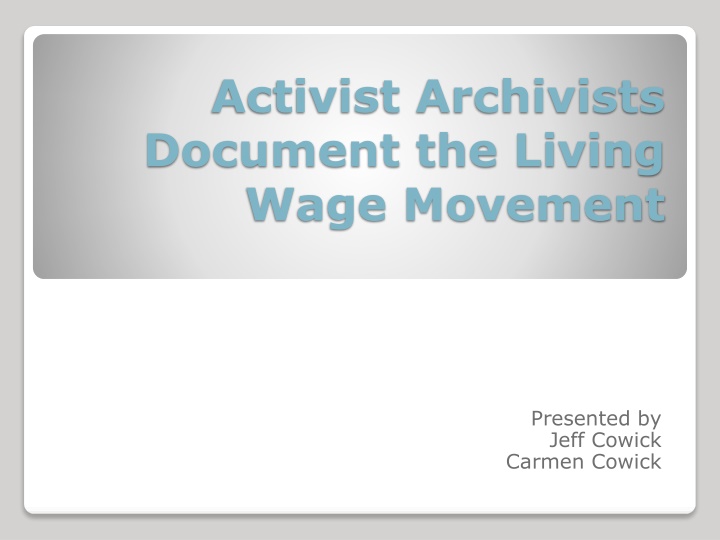
Activist Archivists Document the Living Wage Movement
Explore the Living Wage Project initiated in 2014 to document the ongoing fight for a living wage in the US. Learn about the importance of real-time archiving in social movements and the role of activist archivists in capturing history. Discover the skills required in the 21st century and decisions involved in choosing a digital platform for archiving.
Download Presentation

Please find below an Image/Link to download the presentation.
The content on the website is provided AS IS for your information and personal use only. It may not be sold, licensed, or shared on other websites without obtaining consent from the author. If you encounter any issues during the download, it is possible that the publisher has removed the file from their server.
You are allowed to download the files provided on this website for personal or commercial use, subject to the condition that they are used lawfully. All files are the property of their respective owners.
The content on the website is provided AS IS for your information and personal use only. It may not be sold, licensed, or shared on other websites without obtaining consent from the author.
E N D
Presentation Transcript
Activist Archivists Document the Living Wage Movement Presented by Jeff Cowick Carmen Cowick
An Introduction to the Project The Living Wage Project began in February 2014 as a graduate student-led project intending to document the current movement fighting for a living wage across the United States. In addition to seeking out organizations who are a part of this movement, the project founders were interested in archiving their own archivist experience in the movement by documenting rallies they have attended and donating personal items to the archive.
Archiving Current Social Movements Real-time documentation has its advantages: The ability to cut down on mythmaking, because primary source materials would be readily available. It would cut down on the chances of misremembering the events and dates.
Archiving Current Social Movements (cont d) Real-time documentation has its advantages: Eliminates either undermining or overestimating the importance of a social movement.
Choosing a Digital Platform What software platform should be used to build the site that would best suit the collection? What metadata schema is most appropriate for this type of digital collection? Which plug-ins will offer the best access to the collection; and will they provide improved understanding of the project?
Choosing a Digital Platform (cont d) Is commercial branded software or open- source software better for this project? Which open source software to choose?
The Emergence of the Activist Archivist Traditional Archivist Activist Archivist
The Activist Archivists Skills in the 21stCentury The Activist Archivist needs a full grasp of social media platforms. Twitter Facebook Youtube Flickr
LWPs Oral Histories Collection This collection was created by the founders/archivists themselves, actively soliciting interviews, not just collecting ready-made recordings as with most archival materials of this kind.
Oral History Obstacles Many did not know what an archive was and did not understand why someone would want an oral history of their views and ideas on this subject. Attempting to solicit these interviews on Facebook and giving the option of doing the oral history over the phone proved unfruitful, mostly due to flakiness of the potential participant and not for their lack of consent.
Photographs and Video within the Project Founders Collection The Living Wage Project founders have included in their collection of photographs and videos taken themselves while in attendance at functions of the living wage movement.
Photographs and Videos: Advantages The primary advantage was in not needing to solicit donations from others who were photographing or recording the event. Furthermore, by posting the videos to The Living Wage Project s YouTube account, it allowed traffic to be brought to the digital archive. Links to the videos were also tweeted on Twitter and published on Facebook.
Visit The Living Wage Project at: www.qclivingwageproject.omeka.net qclivingwageproject@gmail.com
